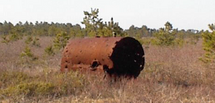 | |||
 | |||
 | |||
 | |||
IntroductionThis fact sheet provides information about the ongoing Impact Area Groundwater Study Program investigations and cleanup actions being conducted at the Central Impact Area, a former artillery and mortar target area at Camp Edwards on the Massachusetts Military Reservation. It provides an outline of the proposed soil removal action (Rapid Response Action) and cleanup in the Central Impact Area. These activities are scheduled to begin in early 2004 and the results will help determine future cleanup plans. The Impact Area Groundwater Study Program, which is managed by the U.S. Army Environmental Center, is conducting an investigation and cleanup of groundwater contamination and its sources at Camp Edwards. Working under the U.S. Environmental Protection Agency (EPA) administrative orders, and in cooperation with the Massachusetts Department of Environmental Protection (MassDEP), the Impact Area Groundwater Study Program is committed to investigating and cleaning up contamination in soil and groundwater on, or emanating from, the base. Information RepositoriesInformation repositories have been established in four local libraries. The repositories are updated regularly to ensure that all necessary documents associated with the cleanup program (including copies of workplans, sampling results, site reports, fact sheets, meeting minutes and other materials) are available to the public. Information repositories locations:
The draft Rapid Response Action Plan for Central Impact Area Soil is available at these locations and on our Web site. For More InformationContact the following individuals for more information:
|
Central Impact Area Soil Rapid Response ActionFact Sheet 2003-03 
The Central Impact Area is located in the northern portion of Camp Edwards and covers approximately 400 acres of the 2,200-acre Impact Area. Artillery, mortar, and other firing activities were directed at this area from the early 1900s until firing ceased in 1997. 
The Impact Area Groundwater Study Program has been conducting soil and groundwater investigations to identify the nature and extent of contamination in the Central Impact Area since 1996. Investigations in the Central Impact Area to date indicate that RDX is the explosive contaminant with the highest concentrations detected in the soil. HMX, TNT, 2A-DNT, 4A-DNT, PETN, and perchlorate also are contaminants of concern. It is believed that RDX and perchlorate in the soil are causing the groundwater contamination beneath the Central Impact Area. Therefore, the Impact Area Groundwater Study Program wants to remove contaminated soil to prevent further groundwater contamination. RDX detections in the groundwater at this location range from the detection limit of 0.25 parts per billion (ppb) to 29 ppb. Perchlorate detections in the groundwater at this location range from the detection limit of 0.35 ppb to 5 ppb. To expedite cleanup while comprehensive measures are identified through the feasibility study process, the Impact Area Groundwater Study Program is proposing a Rapid Response Action to address soil contamination at two former target locations that have high levels of contamination. It is anticipated that the removal of contaminated soil in the vicinity of the target areas will reduce or eliminate a source of contamination. The draft Rapid Response Action Plan for Central Impact Area Soil outlines the proposed activities. The locations for the proposed Rapid Response Action were selected after soil samples were collected at target areas throughout the Central Impact Area. Eleven out of 37 areas contaminated with RDX were considered. Target Areas 23 and 42 were selected for the Rapid Response Action because they are located in areas with higher concentrations of soil contaminants and with a range of contaminants, and they are located away from other targets, making it easier to collect data (see attached map). A detailed analysis, or focused investigation, currently is under way at Target Areas 23 and 42 to determine the concentration of contaminants traveling into the groundwater. The focused investigation includes the following activities:
The information gathered during this focused investigation will be used by the Impact Area Groundwater Study Program to conduct the proposed Rapid Response Action at Target Areas 23 and 42, and to help determine future activities at the remaining target areas in the Central Impact Area. The draft Rapid Response Action Plan for Central Impact Area Soil proposes the following activities at Target Areas 23 and 42:
The need for site restoration activities is proposed to be determined after remedial activities are completed in the Central Impact Area. Next Steps/Upcoming ActivitiesNext steps toward conducting the Rapid Response Action for soil at the Central Impact Area include:
Opportunities for Public CommentA 15-day public comment period will be held on the draft Rapid Response Action Plan for Central Impact Area Soil from December 9, 2003 – December 24, 2003. Visit the IAGWSP website to submit comments. An information session about the plan will be held on Tuesday, December 9, 2003 at 5:30pm at the Holiday Inn hotel in Falmouth. |
|
|
| Administrative Notice |